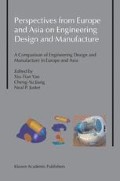Abstract
A primary objective of knowledge engineering is to facilitate the application of knowledge arising from product design and the planning of the manufacturing process for new and modified products. Knowledge is an expensive and valuable commodity so the development of methods for its capture, representation and application are of considerable importance. The emphasis of the research described in this paper is on the re-use of knowledge for the creation of product variants. This implementation of ‘predictive design’ represents the very significant move from standard parts to standard knowledge constructs. Standard parts can be used in any application that requires a defined function where the shape and properties do not need to be altered. However, standard knowledge constructs can provide parts that can be used wherever the function is required. The Process Specification Language (PSL) provides one possible way of achieving this aim and is briefly outlined. A complementary method using ‘knowledge fragments’ for Failure Modes and Effects Analysis (FMEA) applied to electronic products is also described.
Access this chapter
Tax calculation will be finalised at checkout
Purchases are for personal use only
Preview
Unable to display preview. Download preview PDF.
References
Grafton, R. B. (programme manager), Design Assessment and Re-use, NSF Award: #9624231, 1/7/1996 — 30/6/2001.
Hazelrigg, G. A. (programme manager), Rapid Assessment of Early Design: RAED, NSF Award: #9813121, 1998 —2001.
Hazelrigg, G. A. (programme manager): Generative Designer Assistant Tools, NSF Award: #9733434, 1/8/1998 — 31/7/2002.
NIST Manufacturing Engineering Laboratory, Manufacturing Systems Integration division. Web site: http://www.nist.gov/public_affairs/guide/meltx04.htm
Rezayat, M., “The Enterprise-Web protocol for life-cycle support”, Computer Aided Design, Vol 32, pp.85–96, 2000.
Roy, U. and Kodkani, S. S., “Collaborative product conceptualisation tool using web technology”, Computers in Industry, Vol. 41, pp.195–209, 2000.
Schreiber, G., Akkermans, H, Anjewierden, A., de Hoog, R. Shadbolt, N., de Velde, W. V. and Wielinga, R., Knowledge Engineering and Management — The CommonKADS Methodology, The MIT Press, SCH 1 KH 0–262–19300–0, 2000.
Angele, J., Fensel, D., Landes, D. and Studer, R., “Developing Knowledge-based systems with MIKE”, Journal ofAutomated Software Engineering, 1998.
Brazier, F., van Lange, P. H., Treur, J., Wijgaards, N. J. E. and Willems, M., “Modelling an elevator design task in DESIRE: the VT example”, International Journal of humanComputer Studies, 44(3/4), pp.469–520, 1996.
Chaplin, R. V., Li, M., Oh, V. K., Sharpe, J. E. E. and Yan, X. T., “Integrated Computer Support for Interdisciplinary System Design”, Artificial Intelligence in Design ‘94, ed. J S. Gero and F Sudweeks, Kluwer Academic Publishers, pp.591–608, 1994.
Gao, J.X., Tang, Y.S. and Sharma, R., “A feature model editor and process planning system for sheet metal products”, Journal of Materials Processing Technology, 107/1–3, pp.88–95, 2000.
Tang, Y. S., The development of a user oriented process planning system for sheet metal fabrication, PhD thesis, Cranfield University, 2000.
Schlenoff C, Gruninger M, Tissot F, Valois J, Lubell J, Lee J. The Process Specification Language (PSL) Overview and Version 1.0 Specification. [Web Accessed 3rd October 2003]. http://ats.nist.gov/psl
Uschold M, King M, Moralee S, Zorgios Y, 1997. The Enterprise Ontology. Edinburgh University. Unpublished Document [Web Accessed 13th October 2003]. http://tmitwww.tm.tue.nl/staff/gwagner/EnterpriseOntology.pdf
BS 5760 Part 5, Reliability of systems, equipment and components. Guide to failure modes, effects and criticality analysis, 1991.
Price, C.J., Pugh, D.R., Wilson, M.S., and Snooke, N. “Flame system: automating electrical failure mode & effects analysis (FMEA)”, Proceedings of the Annual Reliability and Maintainability Symposium, pp.90–95, 1995.
Dale, B.G., Shaw, P. “Failure Mode and Effects Analysis in the U.K. Motor Industry: A state-of-the-art Study”, Quality & Reliability International, 1996.
Wirth, R., Berthold, B., Kramer, A. and Peter, G. “Knowledge-based Support of System Analysis for Analysis of Failure Modes and Effects”, Engineering Applied Artificial Intelligent, Vol. 9, No.9, pp. 219–229, 1996.
Lee, B.H. “Design FMEA for Mechatronic Systems Using Bayesian Network Causal Models”, Proceedings of the ASME Design Engineering Technical Conferences, Vol. 1, pp.1235–1246, 1999.
Hunt, J.E., Pugh, D.R. and Price, C.J. “Failure mode effects analysis: a practical application of functional modelling”, Applied Artificial Intelligence, Vol 9, 1, pp.33–44, Jan-Feb 1995.
Eubanks, C.F., Kmenta, S. and Ishii, K. “Advanced Failure Modes and Effects Analysis Using Behavior Modelling”. Proceeding of DETC’97, 1997 ASME Design Engineering Technical Conference and Design Theory and Methodology Conference, Sacramento, California, 1997.
Gero, J.S., Tham, K.W. and Lee, H.S. “Behaviour: A Link Between Functional and Structure in Design”. Proceeding of the IFIP WG 5.2 Working Conference on Intelligent Computer Aided Design, Elsevier Science Publisher, 1991.
Russomanno, D.J., Bonnell, R.D. and Bowles, J.B. “Functional reasoning in a failure modes and effects analysis (FMEA) expert-system”. Proceedings of the Annual Reliability and Maintainability Symposium, pp. 339–347, 1993.
Author information
Authors and Affiliations
Editor information
Editors and Affiliations
Rights and permissions
Copyright information
© 2004 Springer Science+Business Media New York
About this paper
Cite this paper
Case, K. (2004). Knowledge Engineering in Product and Process Design. In: Yan, XT., Jiang, CY., Juster, N.P. (eds) Perspectives from Europe and Asia on Engineering Design and Manufacture. Springer, Dordrecht. https://doi.org/10.1007/978-1-4020-2212-8_1
Download citation
DOI: https://doi.org/10.1007/978-1-4020-2212-8_1
Publisher Name: Springer, Dordrecht
Print ISBN: 978-94-015-7003-9
Online ISBN: 978-1-4020-2212-8
eBook Packages: Springer Book Archive

